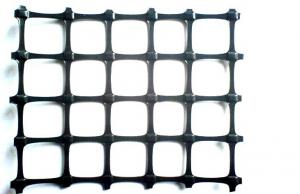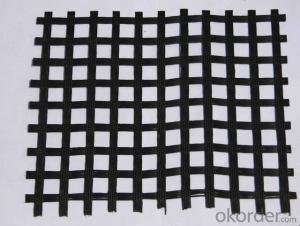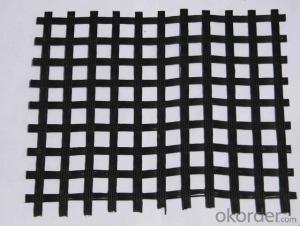Fiberglass Geogrid with CE Certification
- Loading Port:
- Qingdao
- Payment Terms:
- TT or L/C
- Min Order Qty:
- 20000 m²
- Supply Capability:
- 10000000 m²/month
OKorder Service Pledge
OKorder Financial Service
You Might Also Like
Fibergalss Geogrid Profile
Fiberglass geogrid is a new excellent maeterial used for reinforcing road surface and base, it made by fiberglass filament, and covered by special solution. High longitudinal and horizontal strength, low elongation rate, anti-alkali and aging resistance, widely used in asphalt road surface, concrete road surface and reinforceing road base.
Main Features of Fibergalss Geogrid
1.Tensile Strength (KN/m): 30X30KN/M,50x50KN/M,60X60KN/M,70X70KN/M,80X80KN/M
2. Elongation: 3%
3. Mesh Size: 25.4 x 25.4mm or 12.7x 12.7mm
4. Width: 1-6m
5.Temperature Resistance (Centigrade) : -100~290
6.Surface Processing: Modified asphalt or Polymer and self adhesive
7.Packing: with PE bag packing
Also detailed specification may be manufacturered according to your need.
if you are interest in our project, pleas contact me for further information.
Specifications of fiberglass
Specification | 1×1 | 1×1 | 1×1 | 1×1 | 1×1 | 2×2 | 2×2 | |
Strength | Long . Horiz | ≥30 | ≥50 | ≥60 | ≥80 | ≥100 | ≥60 | ≥80 |
≥30 | ≥50 | ≥60 | ≥80 | ≥100 | ≥60 | ≥80 | ||
Percentage of Elongation | 4% | 4% | 4% | 4% | 4% | 4% | 4% | |
Size of Hole mm | 25.4×25.4 | 25.4×25.4 | 25.4×25.4 | 25.4×25.4 | 25.4×25.4 | 12.7×12.7 | 12.7×12.7 | |
Flexibility | 76 | 76 | 76 | 76 | 76 | 76 | 76 | |
Width M | 1--6 | 1--6 | 1--6 | 1--6 | 1--6 | 1--6 | 1--6 | |
Temperature | -100200 | -100200 | -100200 | -100200 | -100200 | -100200 | -100200 | |
FAQ
1.Resistance to Fatigue Cracking of Fiberglass Geogrid
The fiberglass geogrid in asphalt surface can disperse the compressive strength and tensile strength produced when wheels rolled over the pavement. Buffer zone will be formed between two strength areas, and the strength is gradually changed rather than suddenly changed, thus the damage of strength to the asphalt surface is reduced. In the mean time, low elongation rate of the fiberglass geogrid reduced the deflection of the pavement, and protect the pavement from excessive deformations.
2.High Temperature Rutting Resistant of Fiberglass Geogrid
When using fiberglass geogrid in asphalt surface, it acts as skeleton in the surface. Aggregate in the asphalt concrete exists throughout the grid. A composite constraint force in the asphalt surface. The mutual containment of each other in asphalt surface prevents the bed-load of the asphalt surface and resists the effects of rutting.
3.Low temperature shrinkage cracking resistant of Fiberglass Geogrid
In low temperature, asphalt concrete will shrink in cold and tensile strength will be produced. If the tensile strength exceeds the tensile strength of asphalt concrete, it will crack. The application of fiberglass geogrid in asphalt surface, improves the horizontal tensile strength of the surface, and greatly improves the tensile strength of asphalt concrete, thus great tensile strength can be resisted without any damage. In addition, even if some area cracks, the strength in the crack will disappear in their transmission in fiberglass geogrid. Cracks will not develop into fissures.
4.Delay and reduce reflective fissures of Fiberglass Geogrid
Through paving fiberglass geogrid interlayer in the asphalt, the shearing or tensile strength caused by traffic load will be resisted, strain will be released. It will act as tensile improvement material of asphalt concrete, and the purpose to delay and reduce fissures will be achieved.
Product Photos
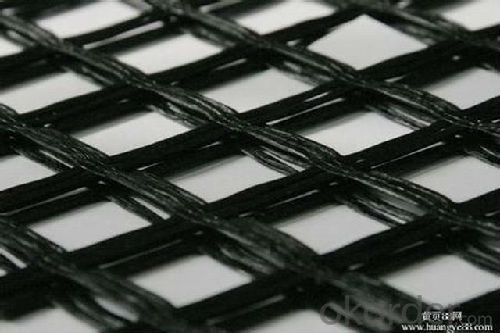
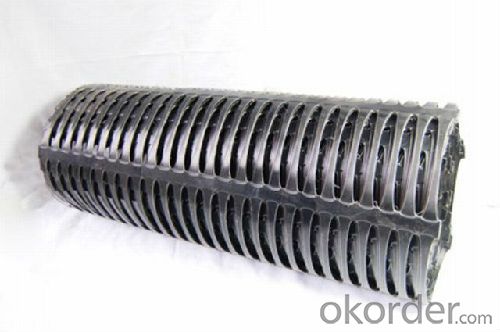

- Q:Are geogrids suitable for reinforcing slope stabilization mats?
- Yes, geogrids are suitable for reinforcing slope stabilization mats. Geogrids are commonly used in conjunction with slope stabilization mats to provide additional strength and stability to the soil. They help distribute loads and prevent soil erosion, making them an effective solution for reinforcing slope stabilization mats.
- Q:How are geogrids installed in the field?
- Geogrids are installed in the field by first preparing the subgrade surface, ensuring it is properly compacted and leveled. Then, the geogrid is unrolled and stretched across the prepared area, with overlaps at the edges for proper connection. The geogrid is then secured to the ground using stakes or pins, ensuring it is taut and properly aligned. Finally, the geogrid is covered with the desired fill material, such as soil or aggregate, which is compacted to provide additional stability and load distribution.
- Q:What are the advantages of using geogrids in construction projects?
- Geogrids offer several advantages in construction projects. Firstly, they provide reinforcement to the soil, increasing its stability and load-bearing capacity. This helps to prevent soil erosion, slope failures, and settlement issues. Secondly, geogrids are cost-effective as they reduce the need for extensive excavation and the use of additional materials. They also facilitate faster construction time as they can be easily installed. Additionally, geogrids are durable and resistant to environmental degradation, ensuring long-term performance and reduced maintenance. Overall, the use of geogrids in construction projects leads to improved safety, enhanced structural integrity, and cost savings.
- Q:Are geogrids environmentally friendly?
- Geogrids can be considered environmentally friendly as they are typically made from recycled materials and can be reused or recycled after their lifespan. Additionally, geogrids help stabilize soil, reduce erosion, and enhance drainage, leading to improved environmental conditions.
- Q:What are the maintenance requirements for geogrid-reinforced structures?
- The maintenance requirements for geogrid-reinforced structures include regular inspections to check for any signs of damage or deterioration, such as cracks or tears in the geogrid material. Any necessary repairs should be promptly addressed to prevent further damage. Additionally, vegetation control should be maintained to prevent root penetration into the structure. It is also important to ensure proper drainage to prevent water accumulation, which can weaken the structure. Overall, a proactive approach to maintenance is crucial to ensure the longevity and effectiveness of geogrid-reinforced structures.
- Q:How do geogrids improve the performance of mechanically stabilized earth walls?
- Geogrids improve the performance of mechanically stabilized earth walls by providing reinforcement and enhancing the stability of the structure. They distribute the applied loads more evenly, reducing potential settling or differential movement. Geogrids also increase the tensile strength and shear resistance of the soil, preventing wall failure and improving overall durability.
- Q:How do geogrids enhance the stability of steep slopes?
- Geogrids enhance the stability of steep slopes by providing reinforcement and increasing the soil's shear resistance. They act as a barrier, distributing the applied loads and reducing the potential for slope failure. Additionally, geogrids improve slope drainage, preventing the accumulation of excess water that can lead to soil erosion and instability.
- Q:What is the lifespan of a geogrid?
- The lifespan of a geogrid can vary depending on factors such as the quality of the material, environmental conditions, and the level of stress it experiences. However, with proper installation and maintenance, geogrids can typically have a lifespan of 20 to 50 years.
- Q:Why should the drainage pipe under the bottom of rubber dam be wrapped with geomembrane
- Geomembrane, generally refers to impermeable material.
- Q:What is the difference between plastic geogrid and grid
- It's not the same thing
1. Manufacturer Overview |
|
|---|---|
| Location | Shandong, China |
| Year Established | 2002 |
| Annual Output Value | Above US$ 20 Million |
| Main Markets | 20.00% North America 15.00% South America 15.00% Eastern Europe 10.00% Southeast Asia 10.00% Northern Europe 10.00% South Asia 10.00% Western Europe 5.00% Africa 5.00% Mid East |
| Company Certifications | ISO9001:2000; |
2. Manufacturer Certificates |
|
|---|---|
| a) Certification Name | |
| Range | |
| Reference | |
| Validity Period | |
3. Manufacturer Capability |
|
|---|---|
| a)Trade Capacity | |
| Nearest Port | Qingdao Port |
| Export Percentage | 41% - 50% |
| No.of Employees in Trade Department | 6-10 People |
| Language Spoken: | English; Chinese; |
| b)Factory Information | |
| Factory Size: | Above 80,000 square meters |
| No. of Production Lines | Above 10 |
| Contract Manufacturing | Design Service Offered; Buyer Label Offered |
| Product Price Range | High; Average |
Send your message to us
Fiberglass Geogrid with CE Certification
- Loading Port:
- Qingdao
- Payment Terms:
- TT or L/C
- Min Order Qty:
- 20000 m²
- Supply Capability:
- 10000000 m²/month
OKorder Service Pledge
OKorder Financial Service
Similar products
New products
Hot products
Hot Searches
Related keywords

























